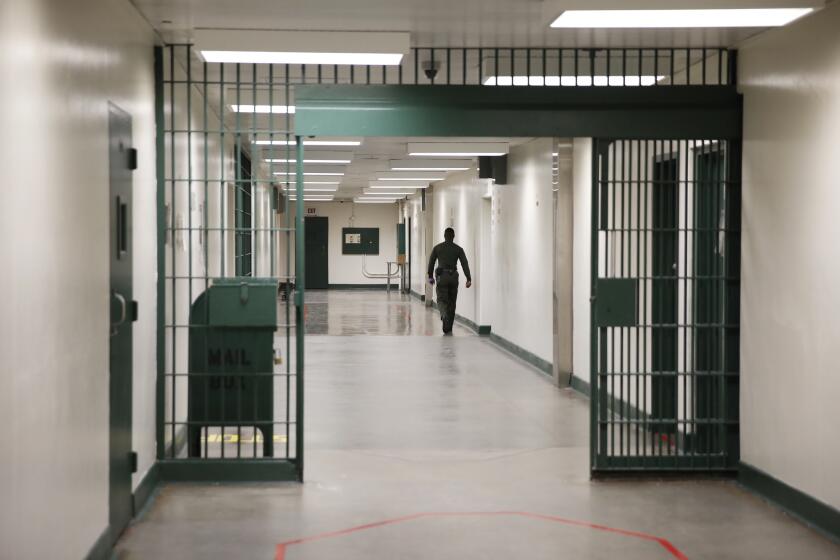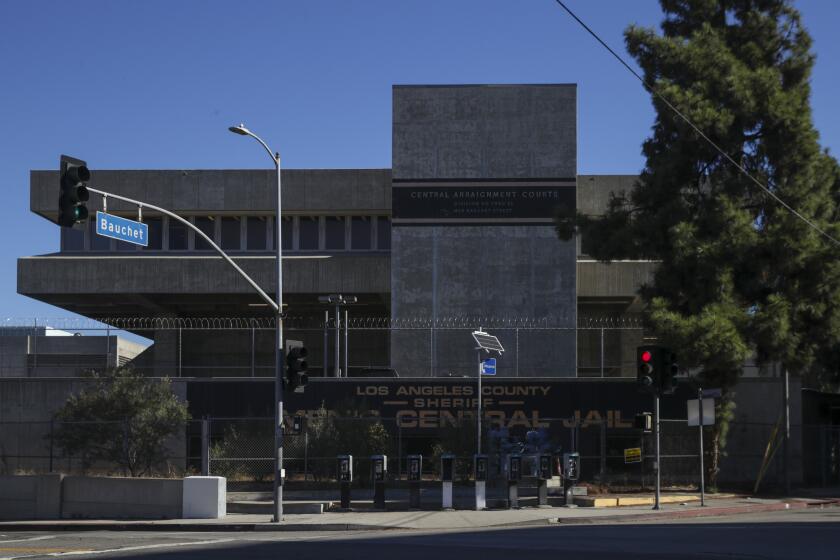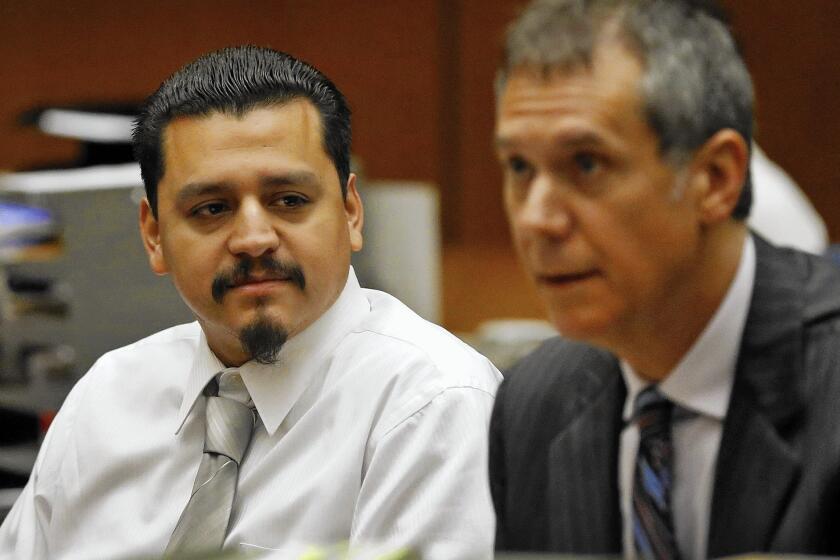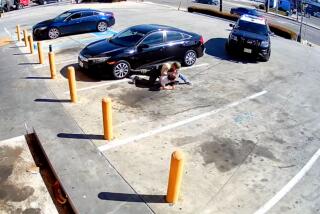D.A. will not charge deputy seen on camera appearing to slam inmate’s head into wall

- Share via
Two years after a Los Angeles County sheriff’s deputy was seen on camera appearing to bash a handcuffed inmate’s head into a concrete wall, prosecutors have decided not to charge either of the jailers involved.
The district attorney’s office explained the move in a memo last month, saying prosecutors couldn’t tell whether the violence was intentional since one of the deputies alleged it was the inmate’s “own momentum” that “caused his head to make contact with the wall.”
The decision comes one year after video of the incident at Men’s Central Jail was made public by the American Civil Liberties Union of Southern California, which posted a 15-second clip of it online. The graphic surveillance video showed two deputies chatting as an inmate emerged from his cell with his hands cuffed behind him.
One deputy appeared to grab the inmate from behind and slam him into the wall, seemingly without provocation. Photos of his injuries show the man sustained a deep 3-inch head wound.
This week, Peter Eliasberg, the ACLU chief counsel involved in two long-standing class-action lawsuits against the jails, denounced the district attorney’s decision not to prosecute the deputies.
“Standing alone, it is nothing short of pathetic,” he told The Times. “But it’s outrageous when you tie it back to the history of the D.A.’s office coddling criminal behavior by the Sheriff’s Department.”
A newly released 15-second security video shows a sheriff’s deputy slamming a handcuffed inmate’s head into a concrete wall.
He said the ACLU plans to ask the U.S. Department of Justice to take up the case, noting that federal prosecutors have previously obtained convictions against other jail deputies prior district attorneys declined to prosecute.
The Los Angeles County district attorney’s office told The Times in an email that it “takes allegations of misconduct by jail deputies extremely seriously” and reviews each case based on the evidence.
“This office thoroughly reviewed the allegations in this case,” the email said, adding that prosecutors “concluded that the allegations could not be proved beyond a reasonable doubt.”
The Sheriff’s Department said in a statement Friday that both deputies are still with the department. Now that the district attorney’s office is done with the case, sheriff’s officials will decide whether the deputies violated any policies or procedures.
“The department expects that custody personnel will perform their responsibilities in a professional manner with integrity and compassion,” the statement said. “Any individuals who fail to uphold our standards of care and violate Department policy will be held accountable.”
The deputies did not respond to emailed requests for comment, and it was not immediately clear whether they had attorneys.
The 2022 incident took place in a high-security unit at Men’s Central Jail, where all prisoners are handcuffed through a door slot before they’re allowed to leave their cells. Whenever they come out, policies dictate that they be escorted by two deputies “who are required to maintain a firm grip on the inmate.”
It’s the same unit, ACLU attorneys said, that has since been the scene of other problems. On Wednesday, The Times reported that oversight inspectors caught eight deputies in the high-security unit watching a “sexually explicit video” instead of tending to a suicidal inmate.
A Men’s Central Jail inmate hung a noose in his cell. Jailers were too busy watching an “explicit video” to intervene, inspectors say.
One inspector described the unit as “moldy” and humid and said the men living there have no books or pens.
“They have absolutely nothing, and it’s completely dark,” oversight commissioner Haley Broder said in an interview. “Being down there for 30 minutes, I don’t know how anyone could survive this.”
According to the D.A.’s memo, the inmate in the surveillance video — whose name was redacted — had been housed in that high-security unit because he’d previously threatened to stab deputies and had an “extensive history” of assaulting people.
On July 4, 2022, the memo said, Deputies Jose Peralta and Johnathan Gutierrez walked up to the inmate’s cell to escort him to the shower. After they cuffed him and he exited the cell, the deputies said he told them: “Don’t touch me.”
Because the surveillance video does not have sound, it’s not possible to tell what — if anything — the three men said. But according to the D.A.’s memo, Peralta claimed the inmate threatened to headbutt Gutierrez.
By Gutierrez’s account, once the inmate exited his cell he quickly turned toward the shower with a “sudden movement” that caught the deputy off guard, according to the memo. Gutierrez reacted by grabbing the inmate’s forearm and reaching for his shoulder. Then, he alleges, the inmate “lunged his upper body forward.”
It all happened so fast, Gutierrez said, that he was focused only on controlling the inmate. According to the memo, the deputy said his right hand “ended up behind” the inmate’s head as the man was moving forward.
“It was his own momentum that caused his head to make contact with the wall,” Gutierrez wrote in a use-of-force report that prosecutors quoted in their memo.
Eliasberg characterized that description as “patently false.”
When investigators interviewed the inmate a few hours after the incident, he seemed to dispute the deputies’ description, too, and said nothing about threatening to headbutt them — but said they had previously threatened him.
“I’m walking out, the cops pulled me out, and I went forward, and he hit me right in the forehead,” he told them, according to the memo. “That’s all I remember. Because the cop told me yesterday that once they get me out of the cell, they were going to get me.”
The memo said he went on to tell investigators that he is on psychiatric medication and believes he has telepathy. When he couldn’t stay on topic, investigators cut the interview short.
The deputies did not provide voluntary statements to investigators, the memo said, though both men wrote use-of-force reports that prosecutors analyzed when evaluating the case.
To prove the deputies committed a crime, prosecutors wrote, they’d have to show that the force was willful, unlawful and “not in self-defense.”
But they said the video appears to confirm the inmate made some “sudden movements” and “began moving his body in the direction of the wall before Gutierrez grabbed” him by the back of the neck.
“It cannot be determined from the video footage whether Gutierrez deliberately slammed” the inmate into the wall or whether it “was accidental,” prosecutors continued, concluding they didn’t have enough evidence to move forward with a case.
Corene Kendrick, another ACLU attorney involved in the jail lawsuits, called that reasoning “mind-boggling,” saying that whether the slam was intentional should be left up to a jury.
“Whether or not the officers willfully smashed the man’s head into the wall or whether his head somehow just hit the wall like they contend, that is something a jury should determine,” she said. “It’s really stunning they would think there was no crime committed here. If an incarcerated person had smashed an officer’s head into the wall and caused those injuries, somehow I don’t think that the district attorney’s office would refuse to prosecute.”
The Los Angeles County Sheriff’s Department already was engulfed in a jail brutality scandal when a prosecutor in the district attorney’s office examined the beating of Gabriel Carrillo.
Nearly a decade ago, the ACLU raised similar allegations in a scathing July 2015 letter to then-D.A. Jackie Lacey. The letter focused on local prosecutors’ failure to charge a group of deputies who beat and pepper-sprayed a visitor they claimed attacked them in 2011.
Initially county prosecutors charged the visitor — Gabriel Carrillo — with battery on a peace officer and other crimes but said there was “no evidence to suggest that the deputies acted inappropriately.”
After the U.S. attorney’s office took over the case, federal prosecutors secured criminal convictions against five deputies, including two who admitted in court that Carrillo had been handcuffed during the attack. Carrillo sued, and the case settled for $1.2 million.
According to the ACLU’s letter, the Carrillo case was part of a larger pattern. The district attorney’s office was quick to file charges against inmates — often without reviewing video evidence — but “almost never” filed charges against deputies, the civil rights organization said.
Eliasberg said this week that little has changed.
“This is just more evidence of the D.A.’s unwillingness to provide accountability for criminal behavior by law enforcement,” he said. “The ACLU will be expeditiously asking the U.S. DOJ to investigate this incident and prosecute as it did in 2011 and 2012.”
Currently, the Sheriff’s Department is subject to several consent decrees stemming from federal lawsuits. One, a case known as Rosas vs. Luna, began in 2012 when inmates alleged “degrading, cruel and sadistic deputy attacks on inmates” had become a common occurrence. Many of the beatings meted out by deputies, the suit alleged, were “far more severe than the infamous 1991 beating of Rodney King.”
After three years of legal wrangling, in 2015 the inmates — represented by the ACLU — and the county came to an agreement about specific changes the Sheriff’s Department would make to reduce the number of beatings behind bars.
Nearly a decade later, there have been some signs of improvement, as county data show that jailers punch inmates in the face far less frequently than they used to. But the department has yet to comply with all of the terms of the agreement. The case continues.
More to Read
Sign up for Essential California
The most important California stories and recommendations in your inbox every morning.
You may occasionally receive promotional content from the Los Angeles Times.













